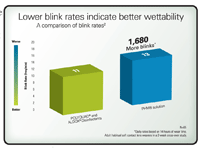Growing our practices requires knowledge, hard work, dedication and resources. Each and every patient who comes into our practice comes at a price, and retaining each of these patients is crucial for continued practice growth. Every patient we lose not only creates a loss in future revenue, but also equals to a loss in the original investment to bring them into our practice. We want to build upon, not replace our patient base.
Contact lens patients provide us with the opportunity to afford our patients enhanced visual options. They come to us motivated and excited to see well—without glasses or surgery. Their expectations are simple: They want to see well and be comfortable. Although this seems straightforward, a recent survey found that 50% of patients drop out of contact lens wear due to comfort issues.1
Contact lens surface wettability is an important factor in contact lens wear. A wet lens surface will stabilize the tear film, allowing each blink to distribute tears evenly over the entire surface providing ocular lubrication.
 The wettability of the contact lens surface is similarly critical to achieving clear vision.2 Contact lens surface wettability is so essential that contact lens manufacturers have developed and implemented their own technologies into the production of contact lenses to enhance surface wettability.3 Advances in technologies and a newly extended range in silicone hydrogel materials are becoming more and more similar to the cornea in many physical properties, although not in dehydration resistance.3 But that is not enough.
The wettability of the contact lens surface is similarly critical to achieving clear vision.2 Contact lens surface wettability is so essential that contact lens manufacturers have developed and implemented their own technologies into the production of contact lenses to enhance surface wettability.3 Advances in technologies and a newly extended range in silicone hydrogel materials are becoming more and more similar to the cornea in many physical properties, although not in dehydration resistance.3 But that is not enough.
By providing patients with a care system that helps keep lenses moist, we can enhance their contact lens experience. This can be achieved by prescribing a solution that establishes excellent contact lens surface wettability. Not all contact lens solutions perform the same with regard to wetting the lens surface. OPTI-FREE-RepleniSH® MPDS has been shown to improve surface wettability when compared to another multipurpose solution tested.5 Pacific University recently performed a study looking at the effects of different MPDS on visual performance of contact lens wearers. Sixty-five adult habitual soft contact lens wearers were evaluated with vision testing and assessment of blink rate and ocular symptoms after using three different MPDS in successive two-week periods in a crossover design, with one-week wash-out between regimen adaptation periods. OPTI-FREE RepleniSH® MPDS resulted in a lower blink rate and lower subjective visual discomfort than Bausch + Lomb’s ReNu MultiPlus® and CIBA Vision’s Clear Care® Disinfecting Solution.2
OPTI-FREE RepleniSH® solution contains the TearGlyde® Reconditioning System, designed to retain moisture on the lens surface for enhanced comfort. Our goal is for our patients to see well and enjoy wearing their contact lenses.
Our patients rely on us to determine what they need in order to achieve the best possible lens wear experience. We have the resources to provide our patients with what they need to be happy in their lenses. On each visit, take the time to make a solution brand recommendation. Your patients will be able to wear their lenses longer throughout the day and thank you by staying with your practice.
1. Rumpakis JR. New data on contact lens dropouts: An international perspective. Rev Optom. 2010 Jan;147(1):1-4.
2. Yang S-N, Ullmann D, Tai Y-C, et al. Effects of lens care solutions on vision performance of contact lens wearers. Presented at the Association for Research in Vision and Opthalmology, May 2-6, 2010; Fort Lauderdale, Fl.
3. Grant R. Developments in contact lens surfaces: Advancements in contact lens surface technology aim at reducing lens-related discomfort and complications. CL Spectrum. 2010 Dec.
4. Ross G, Nasso M, Franklin V, et al. Silicone Hydrogels: Trends in Products and Properties. Poster presented at the British Contact Lens Association meeting, June 3-5, 2005; Brighton, UK.
5. Zikos GA, Kang SS, Nason RJ, et al. Objective in vivo Contact Lens Wettability Testing With Different MPS using the Shack-Hartmann Sensor. Institute for Vision Research. Presented at ARVO, 2008.


